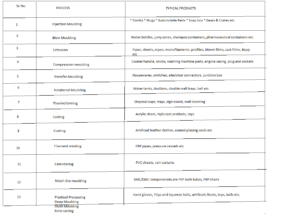Plastic Process Selection
The process selection for producing a specific product depends on the
• Material to be process
• Product design/configuration, tolerance
• Process limitations
• Quality
• Cost/Performance balance
Failure to select a viable process during the initial design stage can dramatically increase development cost and timing. The process can have a significant impact on performance of the finished part.
For Example
• The nature of the process may have a profound influence on a products mechanical strength.
• Excess heat during processing can consume sacrificial heat stabilizers for certain plastics, rendering stabilizers in sufficient to ensured long life at elevated temperatures. Thermal degradation visual product embrittlement.
• The slow cooling of crystalline polymers such as HDPE and PP, can allow large crystal formation to develop. Such crystals embrittle the resin and make it prone to stress cracking.
• The repeat cooling of certain plastic part can produce frozen in stresses and strains (particularly with injection moulding). The stress may decay with time, in viscoelastic manner. However, they will at like any other sustained stress to aggravate cracking or crazing in the presence of aggressive media and hostile environment like UV radiation.
• Annealing at temperatures below the Tg (Glass transaction temp.), where material becomes leathery is not necessarily beneficial. For ex. Annealing a PC generally accelerates both its crazing and rupture under sustain loading. In general, the annealing of a plastic louvers it;s properties, however, it’s dimensional stability may be improve. Heating a material to above heats Tg relieves the internal stresses.
• Knit and well lines from where the melt flow during processing meets after flowing through separate gets in a injection mould or after being part by either spiders in and extruded die or bosses in an injection mould. Because the material is not well mix in the zone of the knit or well line, the seam thus form can be weak or brittle under long term or impact lads. The problem can easily arise with fiber reinforce plastic. Where 40-60% of their strength can be lost, since fibers failed to knit together at their seams.
• In reinforce plastic, in sufficient compaction and consolation of a wet out an capsulation of the fiber and insufficient fiber or uniform fiber content. These deficiencies lead to loss of strength and stiffness and susceptibility to deterioration by water and aggressive agents.
When considering alternative process for producing plastic and composite products, the major concerns usually involve.
• Limitation that may be imposed by the material, because not al materials can be processed by all methods.
• Limitation impose by the designing, such as the size, single piece versus multiple piece construction, a close or open shape and the label of dimensional and tolerance accuracy required.
• The number of product required
• The available capital equipment’s. Certain equipment may already be available and in use. Although it may not necessarily give the lowest production cost.
Summary of Process:






Thanks for the excellent guide
it’s my pleasure sir
It works quite well for me
thank you for visiting this this site